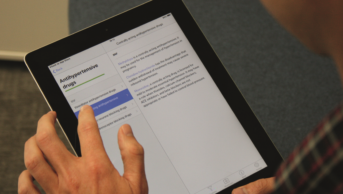This content was published in 2014. We do not recommend that you make any clinical decisions based on this information without first ensuring you have checked the latest guidance.
Patients often need to contact healthcare professionals after being discharged from hospital because they do not understand how to take their medicines, are unsure how to obtain further supplies or are worried about side effects. I believe that patient helplines can play an important part in providing this support to patients and carers.
I have recently worked with a team of medicines information pharmacists and chief pharmacists in the Wessex and Thames Valley region to develop a set of standards on how patient helplines should best be delivered. The standards can be used by service providers as a guide when setting up or reviewing a medicines helpline service (see Box 1).
Box 1: Medicines helplines for patients
The standards specify how a medicines helpline for hospital patients should operate — detailing what constitutes satisfactory practice and the elements that make a service commendable. The standards provide information on:
- How and when patients should be able to access the helpline;
- How the organisation can promote the service to its patients;
- What standard operating procedures need to be in place for staff to be able to provide a safe and effective service;
- What information and professional support staff are required to give informed advice to patients;
- How a service’s quality can be assured and what risk management procedures should be in place;
- Key performance indicators for measuring the value of the service.
Evidence-driven
Our plan was to assist every hospital pharmacy in Wessex and Thames Valley to introduce a medicines helpline for its patients. But to do that we needed standards to aim for, which at the time were not available. The evidence to support how patient helplines can offer substantial benefits to patients and the NHS trusts providing them is growing. A published analysis of 500 patient calls to the Chelsea and Westminster NHS Foundation Trust helpline showed that in approximately one-third of cases an error had possibly occurred, and in 48% of cases the patient could have potentially been harmed if the call had not been resolved[1]. In total, 22% of calls were concerned with interactions, 21% with directions for use and 15% with adverse effects.
There are other studies, too, that have shown that patients themselves consider the provision of a helpline as a positive and beneficial development, and highlight the gaps in patient education and information that lead patients to make contact[2,3].
Further research into patient information requirements supports these findings, and stresses the importance of providing medicines information that meets the needs of individuals[4] — an approach that a medicines helpline is ideally placed to address. The need for individualised services is backed further by another recent study, which revealed that local and personal information sources are needed to answer around half of enquiries made to patient helplines[5]. Local sources include patient notes and dispensing records.
Clear advantages
One advantage of patient helplines that is often missed is that they can provide early warnings about areas of potential risk. Is there a disproportionate number of calls coming from patients treated at the same clinic? Could a simple system change prevent a particular error from happening again? Are there any particular medicines or practices that seem to pose greater risks than others? Analysing helpline enquiries could be valuable in this regard. Other potential advantages of running patient helplines are shown in Box 2.
Box 2: Advantages of helplines
- Avoids harm;
- Adverse effects identified;
- Interactions avoided;
- Non-adherence addressed;
- Supports patient discharge;
- Strengthens discharge counselling;
- Provides assurance that patients can access professional advice at home;
- Mitigates risk;
- Allows for the early identification of potential risks;
- May help the organisation avoid complaints and litigation;
- Can help identify critical incidents and errors;
- Improves patient satisfaction;
- Personalised advice on request could improve patient experience and satisfaction with the trust;
- Creates a channel for feedback on the quality of information provided to patients;
- Reduces readmission rates;
- A helpline service could reduce medicines-related readmissions;
- Trust avoids financial penalties;
- Complies with the national agenda;
- Puts patients at the heart of services;
- Can reduce strain on urgent and emergency care providers;
- Adheres to NHS Constitution, under which patients have a right to information about their treatments;
- Provides an inexpensive, innovative approach to preventing harm, in line with the quality, innovation, productivity and prevention (QIPP) programme;
- Provides a bridge between care settings, assisting transfer of care.
Future opportunities
Our helpline standards link well to existing Royal Pharmaceutical Society professional standards for transfer of care, hospital pharmacy and homecare, and the RPS has now endorsed the standards for national use. Helplines are often run by medicines information pharmacists and the national network for these specialists, UK Medicines Information, is also supporting the initiative and is helping to roll out the standards nationwide. We are working with UKMi to create an implementation guide and a set of adaptable standard operating procedures that trusts can adopt locally.
In future, a helpline service could also be used actively to contact patients after discharge. The clinical pharmacy team could identify and triage patients who they believe are at risk of readmission, harm or non-adherence to medication after leaving hospital, and arrange for the helpline team to offer these at-risk patients support and advice after discharge. A follow-up telephone call could check if the patient had understood how to use his or her medicines and was continuing to take them as agreed, had arranged to see the GP or was responding to therapy as expected.
Collaborating with the clinical pharmacy team in this way would enable the helpline service to become a hub for all post-discharge communication with patients.
References
- Marvin V, Park C, Vaughan L, et al. Phone calls to a hospital medicines information helpline: analysis of queries from members of the public and assessment of potential for harm from their medicines. International Journal of Pharmacy Practice 2011;19:115–22.
- Olofinjana O, Connolly A, Taylor D. Outcomes of information provision to callers to a psychiatric medication helpline. Psychiatric Bulletin 2009;33:364–7.
- Joseph A, Dean Franklin B, James D. An evaluation of a hospital-based patient medicines information helpline. Pharm J 2004;272:126–9.
- Duggan C, Bates I. Medicines information needs of patients: the relationships between information needs, diagnosis and disease. Quality and Safety in Healthcare 2008;17:85–9.
- Parker J, Badiani A, Owen S, et al. Medicines helplines and local knowledge. Poster presented at the UKMi Professional Development Seminar, University of Warwick, 2013.


